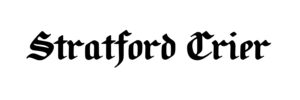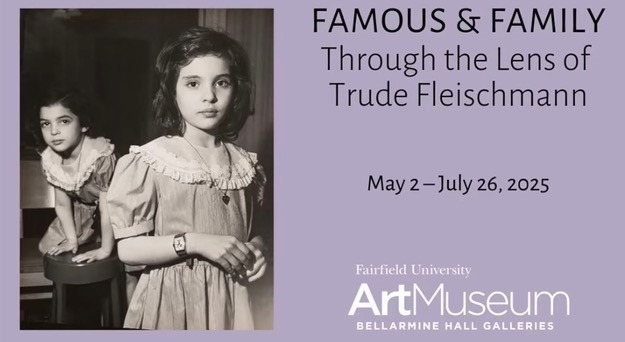Famous and Family: Through the Lens of Trude Fleischmann
Co-Curated by Barbara Rosenberg Loss and Carey Mack Weber
May 2 through July 26, 2025
By Andy Byrne
Austrian-born Trude Fleischmann (1895-1990) was one of the most accomplished female photographers of the 20th century. During the 1920’s and 30’s, she was primarily known for her portraits of major theatrical performers in Europe, the upper echelon of society in Vienna, and dancers in the emerging genre of modern dance, with its movements reflecting the sheer naked freedoms of nature. Her love for Austria itself was embodied in the landscapes and cityscapes that appeared in cultural and social Austrian magazines.
But in 1931, Europe and the rest of the world were in a state of terrifying change. The Austrian Parliament was dissolved in 1933, and after Hitler came to power in Germany that same year, many Jews fled to Vienna. To quote from Heike Herrberg’s rich and compelling history of Trude’s life, told in the magnificent catalog that accompanies this exhibit: “… just one year later, the anti-Semitic slogans in Fleischmann’s homeland became louder, reforms were reversed, democratic committees were dissolved, and the progressive press was banned. A civil war broke out in 1934. In three days, social democracy was crushed.”
Trude was at the peak of her career, but soon, with clients emigrating to save themselves and their families, she realized the true seriousness of the threat to Jewish lives. She abandoned her studio and fled with nothing but some negatives, an album of photographs, and one camera. First to Paris, and then to London, where she applied for a visa to the United States. In March of 1939 she was on a passenger liner to New York. Sadly, Heinrich and Paula Gewitsch Rosenberg, Trude’s aunt and uncle and Barbara Rosenberg Loss’s grandparents, were unable to escape in time and were murdered by the Nazis in 1940.
When Trude arrived in Manhattan on April 4, she was met by Helen Post Modley, a former student and friend, who brought Trude to the small cottage she and her husband owned in Sharon, Connecticut. Helen’s photographic career focused on Indigenous people of the Southwest, and her sister, Marion Post Wolcott, who had also studied with Trude in Vienna, was well-known for her work with the Farm Security Administration during the Great Depression.
In 1940, Trude opened a small studio in New York City, just behind Carnegie Hall. The studio doubled as her apartment and Barbara Rosenberg Loss, Trude’s cousin, recalled: “When we visited Trude, she often told us that she was going over to Carnegie Hall in the evening for a concert or to take pictures of the artists there.” Marian Anderson and Arturo Toscanini were two of them.
Competition in the city was fierce with all the artist refugees fleeing the increasing threats in Europe. In addition to her studio portraits, Trude shot occasional fashion work for Vogue and Glamour magazines. She also exhibited her work at The New School for Social Research, and in 1942 she became an American citizen.
We owe a great debt to Fairfield resident Barbara (Bobbie) Loss for her vision, a vision reaching back many decades—that of bringing the gorgeous and striking photography of Trude Fleischmann to renewed awareness in this country. The vision was realized when she and Carey Mack Weber, Executive Director of the Fairfield University Art Museum, co-curated this first solo museum exhibition in the United States.

On the preview evening, Frauke Kreutler, curator of the Wien Museum in Vienna, gave an engaging talk and presentation of Trude’s professional and personal history. She was responsible for a retrospective of Fleischmann’s work at the Wien in 2011. The following evening, Bobbie, her brother Henry Rosenberg, Heike Herrberg, and Carey Weber had a relaxed conversation with a room full of interested participants, many of whom had provided photographs or other materials for the exhibit. They shared stories of the woman they knew to be not only extremely talented, but loving and adventuresome, a true and authentic individual.

As the title indicates, what makes this exhibit so unique is the blend of portraits of notable Europeans (as well as those better known to Americans, such as Eleanor Roosevelt and Albert Einstein) with the many images of Trude’s close family (Bobbie included) and extended family and friends. As it is with Bobbie, an accomplished photographer in her own right, Trude was never without a camera.
It is a testament to how deeply this family reveres Trude and her work that not only photographs, but letters, notes, and other ephemera are here a century later. Bobbie and Carey spent countless hours over three years’ time reaching out to family, friends, and other sources for the material that makes up this moving exhibit.
I’ve merely touched on moments of Trude’s life, based on conversations and the information in Heike Herrberg’s accompanying book. I sincerely urge you to visit Bellarmine Hall at the Fairfield University Art Museum to see Trude’s work, and to pick up a complimentary copy of Famous and Family, which will tell you so much more about this fascinating woman and the times she lived in.
The Fairfield University Art Museum
Bellarmine Museum of Art, is located on the lower level of Bellarmine Hall
200 Barlow Rd, Fairfield, CT
Museum Hours
Sunday: Closed
Monday: Closed
Tuesday: 11 AM–4 PM
Wednesday: 11 AM–4 PM
Thursday: 11 AM–8 PM
Friday: 11 AM–4 PM
Saturday: 11 AM–4 PM
No charge for admission



